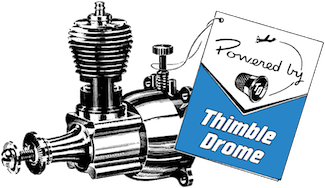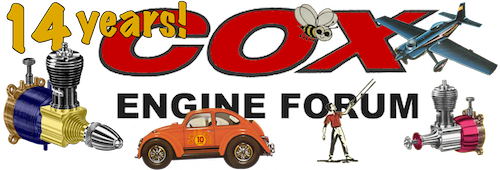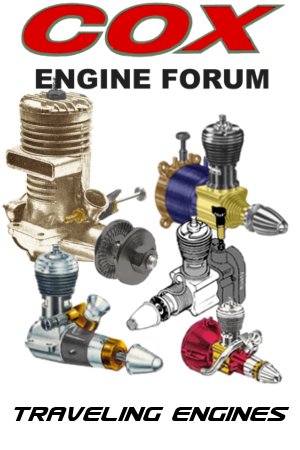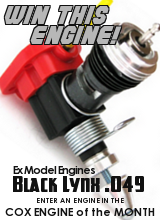Log in
Search
Latest topics
» Stealth SB-Xby Admin Yesterday at 8:28 pm
» ST .35 STUNT / VOODOO / ZERO POINT ZERO NITRO
by TD ABUSER Yesterday at 7:45 pm
» SUPERTIGER .15 PROJECT
by TD ABUSER Yesterday at 7:42 pm
» For sale -- Cox Custom Carburetors for Tee Dee engines
by sosam117 Yesterday at 5:23 pm
» WHERE ARE YOU BUYING YOUR FUEL AND GLOW PLUGS...?
by TD ABUSER Yesterday at 4:35 pm
» Waiting for Engines from Ken Enya
by sosam117 Yesterday at 4:33 pm
» Unusual Cox 049 cylinder - Need help identifying
by anm2 Yesterday at 4:12 pm
» Jim Walker Bonanza etc.
by rsv1cox Yesterday at 2:57 pm
» What's the Best Reed for Cox Reed Valve Engines.
by roddie Yesterday at 1:37 pm
» Fuel choice
by 1975 control line guy Fri Aug 30, 2024 4:01 pm
» "Fall S.M.A.L.L." Video 3.
by GallopingGhostler Fri Aug 30, 2024 2:37 pm
» Gifted Fox
by Ken Cook Fri Aug 30, 2024 11:12 am
Cox Engine of The Month
August-2024
balogh's

"Cox TD09 R/C Beast of Burden featuring Kamtechnik head and DIY metallic fuel nipple"

PAST WINNERS
balogh's

"Cox TD09 R/C Beast of Burden featuring Kamtechnik head and DIY metallic fuel nipple"

PAST WINNERS
How does it work?
Page 1 of 1
 How does it work?
How does it work?
I've used cox engines since i was a kid. Now that I am fixing them, Can someone please explain how the .049 engine works in regards to the glow plug, ignition and the venturi system.

midtown711- Moderate Poster

- Posts : 15
Join date : 2022-11-21
 Re: How does it work?
Re: How does it work?
midtown711 wrote:I've used cox engines since i was a kid. Now that I am fixing them, Can someone please explain how the .049 engine works in regards to the glow plug, ignition and the venturi system.
Watch "Wally wins his Wings". Engine operation starts at 8:39 thru 10:00, but the whole movie is entertaining/educational.
https://www.youtube.com/watch?v=yqDQ1NHGmsQ



Marleysky- Top Poster


Posts : 3618
Join date : 2014-09-28
Age : 71
Location : Grand Rapids, MI
 Re: How does it work?
Re: How does it work?
midtown711 wrote:I've used cox engines since i was a kid. Now that I am fixing them, Can someone please explain how the .049 engine works in regards to the glow plug, ignition and the venturi system.
The 1.5 volt glow plug needs a pair of 1.5 volt D Cell batteries [wired in parallel, not series] to give plenty of engine starts for a day at the field.
It works like a light bulb...if the element is broken it will not pass electrical current and light up. The element can also get "consumed" from the chemical reactions that take place during combustion. In this case it will light as long as the battery is connected, but as soon as you disconnect the battery the engine dies.
Once the engine starts and the battery power is disconnected the glow plug element has a chemical reaction [catalytic reaction with the methanol based fuel] that keeps the glow plug glowing until it runs out of fuel.
Pretty ingenius is what those petro-chemical engineers are who made that discovery.
The ignition is automatic when the compressed fuel / air mixture reaches a critical flash point..because compressed air gets very hot and the glow plug provides just enough extra heat to make combustion a sure thing.
If a 2 stroke engine has any crankcase air leakage..then it won't pump properly or run at all.
with a Cox reed valve engine if the reed gets gummed up with varnish or a foriegn object it won't be free to flutter back and forth in sync with the positive and negative pressure pulses that the piston creates as it goes up and down.
Another problem area with the Cox reed valve engines that have the built in fuel tank is with a small O-ring that prevents the contents of the fuel tank from dumping into the engine [instead of taking the proper route through the feed tube and into the adjustable needle valve.
Youtube video might have a tutorial that shows you how to service the built in fuel system of the Cox reed valve .049

TD ABUSER- Gold Member

- Posts : 224
Join date : 2020-11-01
Age : 68
Location : Washington
 Re: How does it work?
Re: How does it work?
Marleysky wrote:midtown711 wrote:I've used cox engines since i was a kid. Now that I am fixing them, Can someone please explain how the .049 engine works in regards to the glow plug, ignition and the venturi system.
Watch "Wally wins his Wings". Engine operation starts at 8:39 thru 10:00, but the whole movie is entertaining/educational.
https://www.youtube.com/watch?v=yqDQ1NHGmsQ
I remember watching this some time ago, and heck, I will watch it again cause I thought it was neat.

NEW222- Top Poster

- Posts : 3895
Join date : 2011-08-13
Age : 45
Location : oakbank, mb
 Re: How does it work?
Re: How does it work?
Welcome to the best little engine forum on the Internet!
I hope this helps. Note the Wiki link referenced has a moving picture worth watching.
The glowplug gets it's initial heat from a proper battery source, and ignites the air/fuel charge. Ignition timing doesn't exist as it does in spark-ignition engines. I always believed these engines to be a very loose diesel engine/spark ignition-engine like amalgamation because compressing/heating of the atomized air/fuel charge aids the ignition of the charge. I say this because I've never seen raw fuel ignite when dribbled into a hot glow plug. However, it does boil off, and once vaporized I have seen a poof/smoke.
The glowplug's element is made of a material that continues to glow when heat and methanol are present, like during combustion, and loses heat slowly enough to ignite the next air/fuel charges while also absorbing enough heat to "do it again."
https://en.m.wikipedia.org/wiki/Two-stroke_engine
Substitute the sparkplug and related ignition components with your glowplug, already discussed above. Note the vertical side port referenced in the article exists in the cylinder wall on our little engines instead of externally, as in the Wiki-picture. There are variations on our port configurations.
The venturi is on the right side of the moving picture, with a reed cage on the left end. Our reed cages are basically a backplate, retaining ring and reed.
Since you've indicated prior experience with running these engines, I'll be really brief regarding how the venturi operates.
The venturi is basically the air inlet on the outboard part of the air inlet, with a fuel metering needle valve and spray bar, all that you can see looking into the venturi. I consider our CL un-throttled engines to be single-speed, wide-open carburetors. The needle valve allows for adjusting fuel mixture, and when the mixture is not stoichiometricly correct, the engine loses power (especially when rich). As long as (positive) atmospheric pressure exceeds (negative) venturi pressure, air/fuel will be "pushed" to the venturi, and then sucked into the engine.
I'm sure others will come along and add color, just as I did.
I hope this helps. Note the Wiki link referenced has a moving picture worth watching.
The glowplug gets it's initial heat from a proper battery source, and ignites the air/fuel charge. Ignition timing doesn't exist as it does in spark-ignition engines. I always believed these engines to be a very loose diesel engine/spark ignition-engine like amalgamation because compressing/heating of the atomized air/fuel charge aids the ignition of the charge. I say this because I've never seen raw fuel ignite when dribbled into a hot glow plug. However, it does boil off, and once vaporized I have seen a poof/smoke.
The glowplug's element is made of a material that continues to glow when heat and methanol are present, like during combustion, and loses heat slowly enough to ignite the next air/fuel charges while also absorbing enough heat to "do it again."
https://en.m.wikipedia.org/wiki/Two-stroke_engine
Substitute the sparkplug and related ignition components with your glowplug, already discussed above. Note the vertical side port referenced in the article exists in the cylinder wall on our little engines instead of externally, as in the Wiki-picture. There are variations on our port configurations.
The venturi is on the right side of the moving picture, with a reed cage on the left end. Our reed cages are basically a backplate, retaining ring and reed.
Since you've indicated prior experience with running these engines, I'll be really brief regarding how the venturi operates.
The venturi is basically the air inlet on the outboard part of the air inlet, with a fuel metering needle valve and spray bar, all that you can see looking into the venturi. I consider our CL un-throttled engines to be single-speed, wide-open carburetors. The needle valve allows for adjusting fuel mixture, and when the mixture is not stoichiometricly correct, the engine loses power (especially when rich). As long as (positive) atmospheric pressure exceeds (negative) venturi pressure, air/fuel will be "pushed" to the venturi, and then sucked into the engine.
I'm sure others will come along and add color, just as I did.
_________________
Never enough time to build them all...always enough time to smash them all!

944_Jim- Diamond Member




Posts : 2014
Join date : 2017-02-08
Age : 59
Location : NE MS

midtown711- Moderate Poster

- Posts : 15
Join date : 2022-11-21
 Re: How does it work?
Re: How does it work?
Interesting that the sound of the engines in this video don't represent the pitch of a typical Cox engine

706jim- Gold Member

- Posts : 464
Join date : 2013-11-29
 Re: How does it work?
Re: How does it work?
Actually, the glow plug element is more than simply nichrome or similar wire that glows red when a current is passed through it. It is also coated with a special catalytic element like platinum or iridium or both in combination, which reacts with the methanol.944_Jim wrote:The glowplug gets it's initial heat from a proper battery source, and ignites the air/fuel charge. Ignition timing doesn't exist as it does in spark-ignition engines. I always believed these engines to be a very loose diesel engine/spark ignition-engine like amalgamation because compressing/heating of the atomized air/fuel charge aids the ignition of the charge. I say this because I've never seen raw fuel ignite when dribbled into a hot glow plug. However, it does boil off, and once vaporized I have seen a poof/smoke.
The glowplug's element is made of a material that continues to glow when heat and methanol are present, like during combustion, and loses heat slowly enough to ignite the next air/fuel charges while also absorbing enough heat to "do it again."
A combination of the fuel air mixture under compression and the methanol reacting with the platinum/iridium coating on the red hot plug causes the ignition. If the catalytic coating has degraded, then your engine won't run or will run very poorly. A good way to check for this is when the ignition battery is removed from the glow plug, the engine RPM immediately decreases or engine dies. The catalytic action has been lost, unable to keep the glow plug element heated.
About 10 years ago, I bought a card of a dozen Swanson Associates Fireball Red Hot glow plugs. They would work for a day or two. After a week with airplane sitting unrun, my next fly session, the plug acted like it was wore out. I found out that Swanson some time back had received a bad batch of nichrome wire with poor quality platinum coating on it. What appeared to be a bargain (I paid less than $20 for the entire card) really wasn't. This surprised me, because I remembered back in the 1970's, I bought their plugs regularly and never had a problem with them.
Fortunately before the shortages of platinum hit the market, I bought two cards of hot Chinese "no name" plugs. These have been of excellent quality. They were like under $30 each card.

GallopingGhostler- Top Poster


Posts : 5513
Join date : 2013-07-13
Age : 70
Location : Clovis NM or NFL KC Chiefs
 Re: How does it work?
Re: How does it work?
You may also want to read this:
https://drive.google.com/file/d/1f7b_D3UFOlfIlGZUKfx931a_OkCXiMRx/view
https://drive.google.com/file/d/1f7b_D3UFOlfIlGZUKfx931a_OkCXiMRx/view

balogh- Top Poster



Posts : 4852
Join date : 2011-11-06
Age : 65
Location : Budapest Hungary
 Similar topics
Similar topics» P-38 Lightning-Roddie style..
» So, if you were going to permanently attach plastic to balsa
» Help GTP air snorkel
» will this work?
» Stuka Restoration
» So, if you were going to permanently attach plastic to balsa
» Help GTP air snorkel
» will this work?
» Stuka Restoration
Page 1 of 1
Permissions in this forum:
You cannot reply to topics in this forum

 Rules
Rules




